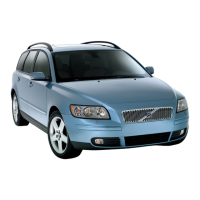103
Starting and driving
If the brake servo is not working
If the car is rolling or being towed with the
engine switched off, approximately 5 times
more pressure must be applied to the brake
pedal than when the engine is running. The
brake pedal feels rigid and hard when the
brake servo is not operating.
Brake circuits
The symbol lights if a brake circuit
is not working
Braking is still possible if a fault occurs in one
of the circuits. Press the pedal hard once.
The brake pedal takes longer to press down
and feels softer than normal. The pedal needs
to be pressed harder for normal braking
power.
NOTE! When braking with the engine
switched off, press the brake pedal once
hard and distinctly, not repeatedly.
WARNING!
The brake servo only works when the
engine is running.
Brake system
Dampness can affect braking
characteristics
Brake components become wet when the car
is driven in heavy rain or through pools of
water or when washing the car. The friction
characteristic of the brake pads may change,
reducing braking power.
• Gently press the brake pedal
occasionally if driving longer distances in
rain or slush and after starting in
extremely damp or cold weather. The
brake pads heat up and the water dries.
This action is also advisable before
parking the car for long periods in these
weather conditions.
If the brakes are heavily loaded
When driving in mountains or on other roads
with similar characteristics, the car’s brakes
are heavily loaded even when not pressing
the brake pedal especially hard.
Because speed is often low, the brakes are
not cooled as effectively as when driving on
flat roads.
To ensure that the brakes are not more
heavily loaded than necessary, shift down on
downhill slopes rather than using the brake
pedal. Use the same gear when driving
downhill as you would uphill. This ensures
that engine braking works more efficiently
and brake use will only be necessary for short
periods. Remember that driving with a trailer
further loads the brakes.
Anti-lock braking system (ABS)
The ABS system (Anti-lock Brake
System) prevents the wheels
from locking when braking. This
maintains the ability to steer,
making it easier to avoid
obstacles.
• After the engine has started and reached
a speed of about 20 km/h (12mph),
there is a short self-test of the ABS
system. This can be both heard and felt
as pulses in the brake pedal.
To fully utilise the ABS system:
• Press the brake pedal with maximum
force. Pulses will be felt.
• Steer the car in the direction of travel. Do
not reduce the pedal pressure.
Practice braking with the ABS system in a
traffic free area and in different weather
conditions.
The ABS symbol lights and remains on:
• for approximately two seconds before
the car starts
• if the ABS system is disabled due to a
fault

